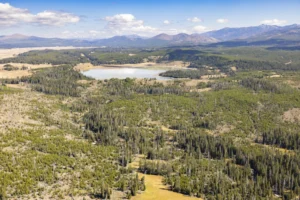Wyoming Considers Increasing Mountain Lion Harvesting
Potential hikes come in response to devastating winterkill loss of mule deer
- Published In: Other News & Features
- Last Updated: Jul 05, 2023

A mountain lion sits in a tree in Yellowstone National Park in this undated photo. Wyoming Game & Fish Department officials are evaluating temporary increases in mountain lion hunting tags to help struggling mule deer populations. (Courtesy photo from the National Park Service)
By K.L. McQuaid
Special to the Wyoming Truth
This story was updated for clarity on July 6, 2023 as of 2 p.m. MT.
State wildlife officials are evaluating whether to increase the total harvest of mountain lions later this year in a bid to help mule deer populations that were decimated by the harsh winter rebound.
In four hunting regions in the Wyoming and Salt River ranges in the western part of the state, the proposed taking will increase the number of mountain lions that can be killed from 46 to 70.
Wyoming Game & Fish Department officials said the temporary 50% increases in the four areas are part of a larger, continuous effort – along with habitat maintenance and augmentation – to bolster deer populations.
“This is being considered out of an overall sense of compassion for mule deer,” Dan Thompson, the department’s large carnivore supervisor, told the Wyoming Truth. “Predation is a component, but it’s complicated. Mule deer are always a top priority for the department. They’re an iconic species, and they’re important to have.”
Department officials will hold a series of public hearings to receive comments on the proposal throughout July at Game & Fish regional offices in Laramie, Cody, Lander, Green River, Jackson and Pinedale, respectively. Meetings were held last month in Sheridan and Casper.
The first scheduled meeting this month will take place on Thursday in Laramie.
Public comments also can be submitted online through Aug. 4.
The Game & Fish Commission is slated to review the comments before deciding on the issue during its Sept. 12-13 meeting in Gillette.
The potential effort to reduce the numbers of a key predator marks the latest step in a series of moves aimed at boosting mule deer populations statewide.
In April, commission members voted to shave over 4,400 mule deer hunting tags off the total that will be issued this Fall. Various parts of the state also will limit the number of days deer hunting is permitted this year – in some areas shrinking the season by half.

hold public hearings to receive comments on the proposal throughout July at the department’s regional offices. (Courtesy photo from the National Park Service)
At least seven other Mountain and Great Plains states, including Colorado, Utah and North Dakota, have decided to reduce their numbers of deer licenses. In all, over 40,000 fewer tags will be issued.
The push to limit the number of tags and possibly go after predators comes amid increasing evidence the 2022-2023 winterkill was significantly more severe than previously believed.
In some parts of the state, estimates now indicate the harsh winter claimed nearly 100% of all fawns.
In addition to predators, mule deer also have for several years battled dwindling food supplies, drought and Chronic Wasting Disease that have eroded their numbers. Between 1990 and 2015, Wyoming’s mule deer population fell by nearly one-third, according to state estimates.
In 2016, about 29,310 mule deer were harvested. Six years later, that figure fell to about 17,590, state figures show.
“This past winterkill was just incredible,” said Sy Gilliland, founder of SNS Outfitters & Guides, the state’s largest outfitter. “We’ve found several areas where it appears that 95% of the mule deer population was wiped out. I think it’s worse than the state realizes.”
Gilliland, the current president of the Wyoming Outfitter & Guides Association, also questions whether the increased number of mountain lion tags will be enough to have any significant impact.
“What we need is an unlimited quota,” said Gilliland. “I think mule deer will continue to struggle until we get predators under control. It’ll be a long recovery regardless. If everything goes right, I think we’re still looking at 10 to 15 years before they fully rebound.”
Mountain lion tags are set on a three-year cycle; the current harvest was approved in July 2022. Any changes to those limits must also be approved by the governor.
Although mountain lion hunting season technically begins on Sept. 1, most harvesting is done between November and March. The season ends when the quota limit is met.
Game & Fish’s Thompson said boosting mule deer numbers requires a comprehensive approach.
“Killing more mountain lions will not save mule deer,” he said. “Increasing the harvest can help, but not as much as augmenting and maintaining habitat. We also need to work on protecting migration corridors.
“All of that is being done, but it requires patience,” Thompson said. “Those efforts take longer to pay out dividends.”
Thompson added that he’s encouraged by the amount of new green vegetation he’s seen in the field, which will, in turn, bolster future mule deer viability.
“If we can help them go into this winter healthy, then that’s going to result in a good fawn crop,” he said.













